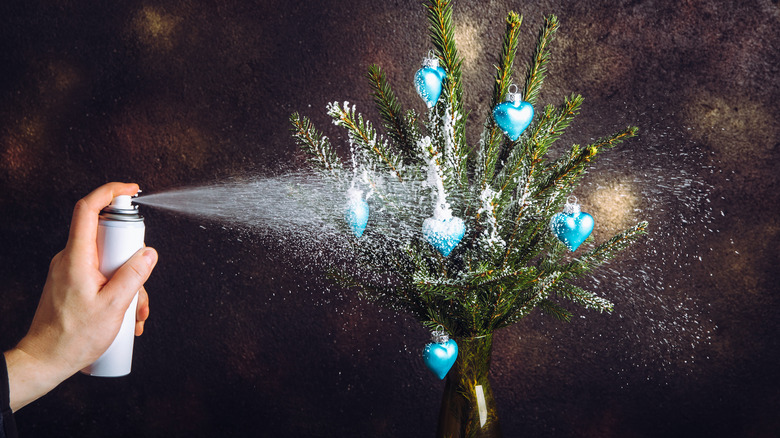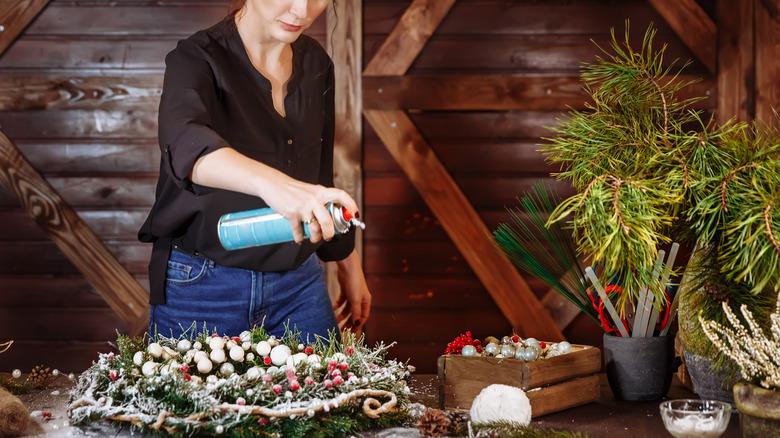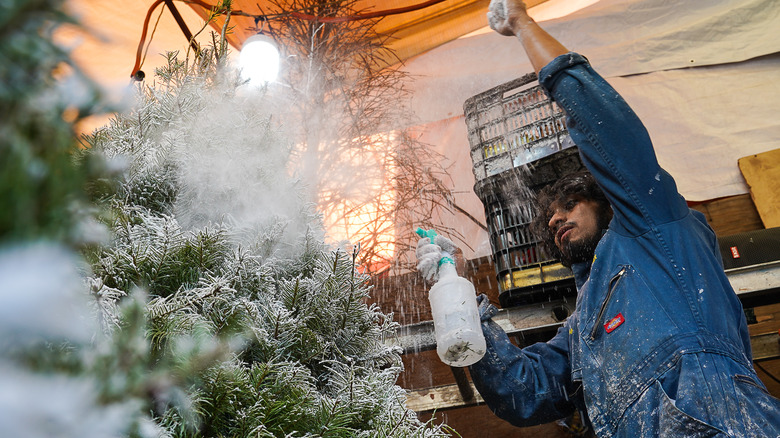The Huge Mistake People Make When Frosting Evergreen Christmas Trees
Is there anything more beautiful than winter sunlight gleaming on fresh snowy branches? Frosting or "flocking" holiday trees is an easy way to add some extra dimension and texture to an otherwise standard evergreen. For centuries, people sprinkled loose materials like flour, cotton bits, or corn starch onto their greenery until artificial snow powder was invented and popularized in the mid-1900s. The original flocking dust can be a little confusing and messy to use, so eventually spray can snow was invented to make it easier to dust your decor in a fresh coat of sparkling white. However, spray snow isn't ideal for flocking a whole evergreen. Though many people make the mistake of using the spray, you're better off sticking to the original stuff if you want a luscious layer of white on your holiday tree.
Artificial frost can bring the magic of a winter wonderland into your living room sans wet floors, but there are some do's and don'ts that will help you flock your own Christmas tree without making a mess or spending more than you should. Here's why artificial spray snow doesn't work well for flocking a whole tree and what you can do to make the traditional flocking process easier.
Spray snow isn't for large projects
Canned snow is intended for highlighting wreaths, pine cones, Christmas ornaments, and other small pieces of decor. It can also be used to frost and decorate windows, mirrors, and other smooth, poreless surfaces. While it can be used to flock the tips of your holiday tree, canned spray snow isn't the best method for creating that lush, full, snowstorm effect that many people strive for on their holiday trees.
If you attempt to flock a whole evergreen tree with spray snow anyway, you'll probably find that multiple layers are necessary to achieve the perfect thick and frosty look. Not only will the spray take a lot of time to dry between layers, but you'll likely end up making a bigger mess and spending more money in the long run than you would with traditional powder. Artificial snow spray costs around $0.92 per ounce while flocking powder costs about $0.57 per ounce.
Even after applying and reapplying the product, your sprayed tree may look a little fake because the aerosol can blasts snow in strange directions. Because traditional powered snow doesn't use aerosols, you're less likely to have any drastic messy overspray. You'll also end up with a more natural snowfall look with the powder brought on by gravity.
Use powder and water for an intense effect
Using a snow powder like this one from Amazon is ideal for trees because it gives a thicker, heavier look. Flocking snow is usually made of a polymer and leaves behind a residue of harmless calcium or vegetable and animal fats, but it's still a good idea to apply the product outdoors in a well-ventilated area for several reasons. Firstly, applying the snow outdoors will help you avoid overspray and make less of a mess in your home. Secondly, moving the tree outdoors or into a garage first will give you more room to walk around all sides of the tree and ensure an even coating of snow. Finally, flocking outdoors will avoid excessive inhalation of the snow particles or vapors as well as enable the wet material to dry more quickly.
To use traditional flocking powder, fill an empty spray bottle with clean water and put it on a fine mist setting. Mist the whole tree with a light coat of water, then use a mesh strainer to sift the powder over branches, focusing on the tips. Here's the tricky part: as the snow is falling, use your free hand to continue spraying water as it lands, binding it to the branches in delicate clumps. For a more natural look, be sure to sift from high above the tree so the snow will rest only on the top of the needles, leaving the underside green. You can also apply an even, heavy coat for a blizzard-frosted look.


